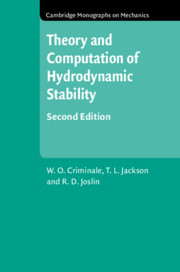Refine search
Actions for selected content:
8124 results in Fluid dynamics and solid mechanics
Appendix B - Numerical Methods
-
- Book:
- Theory and Computation in Hydrodynamic Stability
- Published online:
- 22 November 2018
- Print publication:
- 06 December 2018, pp 401-412
-
- Chapter
- Export citation
Contents
-
- Book:
- Theory and Computation in Hydrodynamic Stability
- Published online:
- 22 November 2018
- Print publication:
- 06 December 2018, pp v-viii
-
- Chapter
- Export citation
9 - Nonlinear Stability
-
- Book:
- Theory and Computation in Hydrodynamic Stability
- Published online:
- 22 November 2018
- Print publication:
- 06 December 2018, pp 259-286
-
- Chapter
- Export citation
3 - Temporal Stability of Viscous Incompressible Flows
-
- Book:
- Theory and Computation in Hydrodynamic Stability
- Published online:
- 22 November 2018
- Print publication:
- 06 December 2018, pp 76-97
-
- Chapter
- Export citation
Author Index
-
- Book:
- Theory and Computation in Hydrodynamic Stability
- Published online:
- 22 November 2018
- Print publication:
- 06 December 2018, pp 544-548
-
- Chapter
- Export citation
10 - Transition and Receptivity
-
- Book:
- Theory and Computation in Hydrodynamic Stability
- Published online:
- 22 November 2018
- Print publication:
- 06 December 2018, pp 287-315
-
- Chapter
- Export citation
2 - Temporal Stability of Inviscid Incompressible Flows
-
- Book:
- Theory and Computation in Hydrodynamic Stability
- Published online:
- 22 November 2018
- Print publication:
- 06 December 2018, pp 26-75
-
- Chapter
- Export citation
NEW ADAPTIVE BARZILAI–BORWEIN STEP SIZE AND ITS APPLICATION IN SOLVING LARGE-SCALE OPTIMIZATION PROBLEMS
- Part of
-
- Journal:
- The ANZIAM Journal / Volume 61 / Issue 1 / January 2019
- Published online by Cambridge University Press:
- 03 December 2018, pp. 76-98
-
- Article
-
- You have access
- Export citation

Theory and Computation in Hydrodynamic Stability
-
- Published online:
- 22 November 2018
- Print publication:
- 06 December 2018
11 - Propagating Transformations of State in Self-Organizing Systems
-
- Book:
- Impact Mechanics
- Published online:
- 19 October 2018
- Print publication:
- 15 November 2018, pp 264-292
-
- Chapter
- Export citation
Index
-
- Book:
- Impact Mechanics
- Published online:
- 19 October 2018
- Print publication:
- 15 November 2018, pp 353-362
-
- Chapter
- Export citation
References
-
- Book:
- Impact Mechanics
- Published online:
- 19 October 2018
- Print publication:
- 15 November 2018, pp 344-352
-
- Chapter
- Export citation
Permissions
-
- Book:
- Impact Mechanics
- Published online:
- 19 October 2018
- Print publication:
- 15 November 2018, pp 342-343
-
- Chapter
- Export citation
Preface to Second Edition
-
- Book:
- Impact Mechanics
- Published online:
- 19 October 2018
- Print publication:
- 15 November 2018, pp xi-xii
-
- Chapter
- Export citation
Contents
-
- Book:
- Impact Mechanics
- Published online:
- 19 October 2018
- Print publication:
- 15 November 2018, pp vii-x
-
- Chapter
- Export citation
10 - Impact against Flexible Structures
-
- Book:
- Impact Mechanics
- Published online:
- 19 October 2018
- Print publication:
- 15 November 2018, pp 246-263
-
- Chapter
- Export citation
2 - Collinear Rigid Body Impact
-
- Book:
- Impact Mechanics
- Published online:
- 19 October 2018
- Print publication:
- 15 November 2018, pp 21-34
-
- Chapter
- Export citation
8 - Generalized Impact Analysis of Multibody Systems
-
- Book:
- Impact Mechanics
- Published online:
- 19 October 2018
- Print publication:
- 15 November 2018, pp 177-224
-
- Chapter
- Export citation
Appendix A - Role of Impact in Development of Mechanics during the Seventeenth and Eighteenth Centuries
-
- Book:
- Impact Mechanics
- Published online:
- 19 October 2018
- Print publication:
- 15 November 2018, pp 317-335
-
- Chapter
- Export citation
Answers to Some Problems
-
- Book:
- Impact Mechanics
- Published online:
- 19 October 2018
- Print publication:
- 15 November 2018, pp 339-341
-
- Chapter
- Export citation
